The military breakthrough for Bergmann finally came in 1903 with a new locking system for the pistol, designed by Louis Schmeisser (who had also designed the previous Bergmann handguns). In 1901, Schmeisser developed the new lock, and it was patented by Bergmann (his employer) primarily for use on heavy machine guns. It was used in these (and Bergmann HMGs saw some use in WWI), but it was also scaled down for use in the 1903 pistol. The new system used a square block that encircled the bolt and could travel a few millimeters up and down. When the bolt was locked, this block would rise up so that its bottom surface was captive in the bolt and its top surface was locked against a block in the bolt carrier. This held the bolt and carrier locked together, so that upon firing they would recoil together. After a short travel, angled camming surfaces in the frame of the pistol would force the locking block downward, freeing it from both the bolt and bolt carrier. Once the gun was thus unlocked, the bolt could continue traveling rearward on its inertia to eject the empty case and load a new one. This system externally looks very similar to the C96 Broomhandle Mauser, but is mechanically reasonably different.
Mechanically, the system is identical to the 1910/21 version, so you can see here for disassembly:
This new locking system was more cost effective to manufacture and more reliable than the side-tilting bolt of the 1897 Bergmann, and it was also quite strong. Bergmann exploited this strength by introducing a new cartridge for the 1903 model – the 9mm Bergmann (clever name, eh?). Thanks to the Spanish, we know this round today as the 9mm Largo. It was a 9x23mm case, firing a 135 grain FMJ bullet at 1060-1115 fps (325-340 m/s) depending on the loading. This was the most powerful production pistol cartridge designed in continental Europe at the time, and had performance very similar to Browning’s .38 ACP.
With this improved system, Bergmann finally had a product that would be appealing to military buys – but he still had to undergo testing and trials and actually make a sale. The British tested a .455 caliber Bergmann-Mars in 1903, but rejected it for not having a heavy enough projectile (they were pretty picky).
Two Bergmann-Mars variant were sent to the US for testing. The first, in 1906, was chambered for a proprietary 11.35mm cartridge (probably the same one sent to the British, but I can’t confirm that). The ammunition sent with it was impounded by US customs upon arrival, and the gun could not be tested (bureaucracy never changes). A second model chambered for standard .45ACP was sent shortly thereafter (for the US 1907 pistol trials) with German-made ammo. Once again, the ammo was impounded on arrival. In this case, testing was able to continue Frankford Arsenal ammunition. Unfortunately, in the first firing test the hammer was unable to strike hard enough to detonate the Frankford primers, and the pistol was dropped from testing (the board report also records that they did not like the forward-magazine configuration). In retrospective fairness to Bergmann, and ammo used for the 1907 trials was pretty crummy stuff and caused problems for all of the competing pistols.
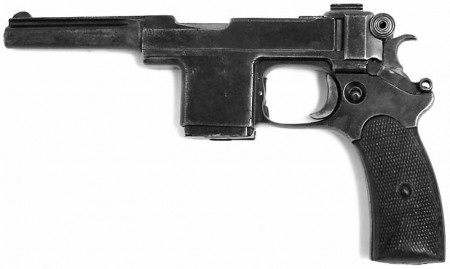
Bergmann’s first major break came in 1905 when a Spanish testing board officially recommended the 1903 for military purchase and use. On September 5th of that year Spain placed and order for 3,000 Model 1903 pistols, chambered for the 9x23mm cartridge. This brought along a new problem for Bergmann – how to actually make them. Since 1896, Bergmann pistol production had been subcontracted out to V.C Schilling in Suhl, and Bergmann’s own industrial works were not tooled up for pistol production. In 1904 Schilling was taken over by the Krieghoff company, which decided to end the factory’s relationship with Bergmann.
The cost of setting up a pistol production line is quite significant, and Bergmann knew that his previous pistols had never managed to bring really significant sales numbers. Being the intelligent businessman, he was hesitant to make the investment in tooling and jigs for the 1903 without having more than the relatively small Spanish order. His solution was to use the facilities he had already set up for making the various prototype 1903 pistols. This allowed some production, but not at a very fast pace. In addition to the Spanish order, this production had to include commercial sale guns and samples for other testing (like the US trials). Bergmann’s own plant produced less than a thousand model 1903 pistols in total, and only a small number of these were sent to Spain by 1908.
Presumably Bergmann spent the years between 1905 and 1908 looking for a new subcontractor to manufacture his pistols – someone with adequate firearms experience. By 1908 he had found such a firm – the longtime armsmaker: Societe Anonyme Anciens Establissments Pieper located in Herstal Belgium. AEP was willing to finish making the pistols for the Spanish order, and was also granted a license to manufacture and market the 1903 pistol commercially. They did this under the trade name “Bayard” – which is why these later Bergmanns are often called Bergmann-Bayard pistols. These Belgian-made examples have serial numbers starting at 1000.
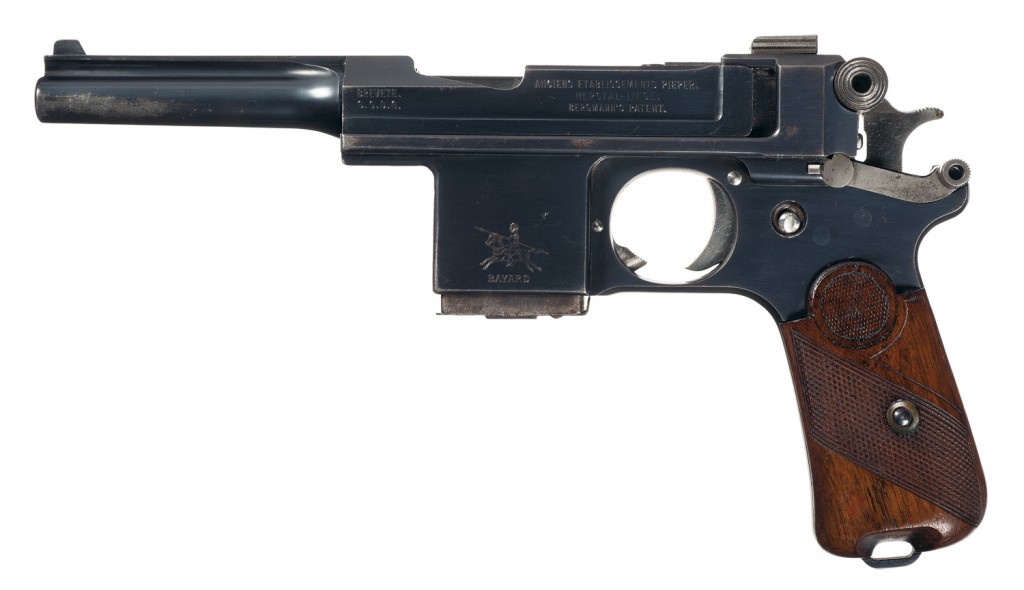
By the time AEP was contracted to build these pistols, the Spanish military had spent several years with their first examples and had come up with some improvements they wanted to make to the design. These were mostly minor changes – larger mag catch, shortened safety lever throw, tweaks to the grip shape, etc. The two major changes were the addition of a disconnector (to prevent unintentional full-auto fire) and making the barrel and bolt carrier from a single piece of material instead of threading the barrel into the carrier as the original 1903 did. With these changes, the design was known as the Model 1908, and AEP completed the 3,000-gun Spanish order of these by the end of 1909. The 1908 model also incorporated a pin that would recock the hammer upon cycling, rather than having the bolt itself slam back into the hammer on each shot.
The recommendation of the 1903 Bergmann had roused the interest of Spanish army officer Venancio Lopez in automatic pistol design, and he began experimenting with his own design that year. By 1912 his pistol design had been perfected and successfully endured military trials. It was known as the Campo Giro, and was adopted as the official Spanish military pistol that year, ending Spanish interest in the Bergmann (although the existing Bergmanns would continue to see service with police units until 1939). Spanish 1903 and 1908 Bergmann pistols can be identified by the early Spanish military acceptance mark, a circle divided into equal thirds located atop the chamber and on the left side of the frame.
We will finish up this series on Bergman pistols Wednesday, with the Danish M1910…
Technical Specs
| Model 1903 | Model 1908 | |
| Caliber | 9x23mm Bergmann | |
| Bullet Weight | 135 grains | |
| Muzzle Velocity | 1060-1115 fps (325-340m/s) | |
| Magazine Capacity | 6 rounds | |
| Weight | 32oz (908g) | 36oz (1020g) |
| Barrel Length | 4.25in (108mm) | 4.0in (102mm) |
| Rifling | 4-Right | 6-Left |
| Action | Short recoil | |
| Locking System | Vertically moving block | |
Manuals
German-language manual for the M1908 Bergmann-Bayard:
Photos
PistolCollection.com has a nice set of photos of a German-made 1903 Bergmann Mars (s/n 508).
We also have photos of a very early Bergmann-Mars, s/n 108. This was from the Schroeder collection, and included an original holster-stock (which was available commercially, but not purchased by the Spanish). This one was sold by James Julia Inc:
We also have photos of a later German 1903 from the September 2013 Rock Island Auction (the same pistol we have a video of, s/n 245 with a mismatched magazine):
Patents
US Patent 723,232 (T. Bergmann, “Automatic Machine Gun”, March 24, 1903)
References
Ezell, Edward C. Handguns of the World. Stackpole Books, New York, 1981.
Wilson, R.K. Textbook of Automatic Pistols. Samworth, 1934 (reprinted by Wolfe Publishing, Prescott AZ, 1990).
Buffaloe, Ed. Bergmann Bayard (web site)

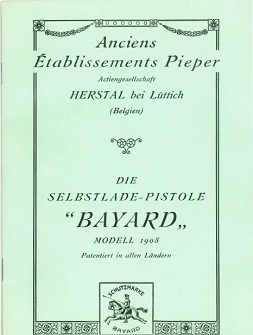





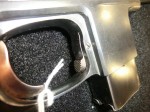
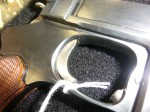


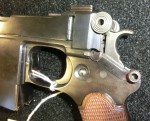
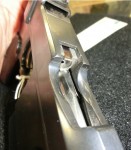
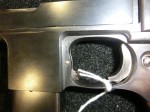






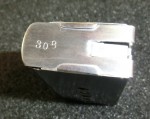
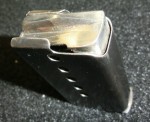





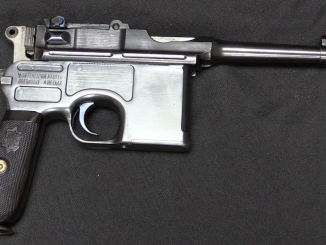
Tnanks so much!
Approximately contemporaneous with the 9X25mm Mauser export.
Yep, it was a close second – the 9×25 Mauser was 128gr @ ~1300 fps.
From how long barrel?
From automatic or hand-repeated weapon?
AFAIK(going by Hogg & Weeks, Military Small Arms of the 20th Century), the 9mm Mauser export was only ever chambered in the C96 “Broomhandle” type pistol (normally a 5.5″/139mm barrel) and two submachine guns, the Swiss-made Steyr-Solothurn SI-100 and (possibly) the MP-18″I” (or if you prefer, MP-28) version of the original Bergmann Muskete with the box magazine instead of the original Trommelmagazin 08 inherited from the Parabellum pistol.
(The MP-18I is uncertain; it was cataloged in 9 x 25mm, but it was also cataloged in .45 ACP, and no one has ever seen one in that particular caliber. Most production was in 9 x 19mm or 7.63 Mauser, with some in 7.65 Parabellum.)
Since both SMGs had 7.75″/196mm barrels, velocity from them wasn’t likely to be too much greater than from the “Broomhandle”.
Keep in mind that the pistol is locked-breech, the SMGS were blowbacks firing from open bolts, with bolts light enough to result in a 500 RPM rate of fire. So it’s pretty certain that there was still residual pressure in the barrel when the cases ejected, i.e., not all the power of the burning propellant was concentrated on the bullet, there was some wastage.
Ezell (above) lists the MV of 9 x 25 Mauser as 412m/s with an 8.1 gram bullet, or 1,350 FPS with a 125-grain in English measure. This works out to a ME of 504 FPE (680J), which puts it in the same ballistic class as the modern 125-grain .357 Magnum loads from a 4″ revolver. Pretty impressive, even today.
cheers
eon
9x25mm Mauser was also the chambering of Hungarian Király Danuvia 39.M smg
http://www.hungariae.com/Danu39.htm
which have 500mm long barrel, in link you can read about muzzle velocity 425m/s…463m/s, but bullet weight is not specified.
Thanks. I’ve always wondered if the Kiraly 39’s round was the 9×25 or something like a 9×21 Steyr.
With a 50cm barrel, I’d expect higher MV than with the shorter barrels. 463 m/s (1520 FPS) would put it close to the Czech loading of the 7.62 x 25 in the VZ24 and VZ26 SMGs. Or in other words, getting up into U.S. .30 Carbine territory.
cheers
eon
Specs from В.Е. Маркевич “Ручное огнестрельное оружие”
Bergmann 1903
caliber: 7,65mm, 9mm, 10mm (rare) or 11mm (rare)
ammo capacity: 6 or 10
loading method: bottom-inserted magazine, can also be loaded from top with plastic charger
spec for Spanish 1903 pistols:
caliber: 9mm
weight: 900g
length: 250mm, barrel: 100mm
muzzle velocity: 400m/s, muzzle energy: 44,8kgm
В.Е. Маркевич states that the pistol drawback was short barrel (100mm or 4inch)
Bergmann 1903-1908 “Bayard”
caliber: 7,65mm or 9mm
ammo capacity and loading method: as in Bergmann 1903
ammo spec:
bullet weight: 8,3g
powder charge: 0,45g
cartridge weight: 12,75g
cartridge length: 35,5mm
muzzle velocity: 400m/s, muzzle energy: 44,8kgm
pistol dimensions:
length: 250mm, height: 145mm, width: 32mm, weight: 900g
Pistol have detachable holster-stock
Hi guys, I just saw the performance figures and wondered how this pistol would be used in combat. Would the Bergmann-Mars be a good trench-raiding gun? I would hope so, as the reloading process looks a bit fiddly with the button release. Again, do not hide behind furniture or foliage! 9 mm Largo will probably smash through walls and anyone behind them, though we don’t have wood-thickness penetration numbers here. I would also hate to get pistol-whipped by the Bergmann-Mars (by the butt-stock, not the barrel).
Extra: Ian, have you ever researched the Spanish Destroyer Carbine?
I don’t know about the 9 x 25mm (except that by Hatcher’s P= E/RA formula it should punch through about 14 22mm pine planks), but according to Ezell, in the British Army pistol trial of 1900, Bergmann submitted two different 10mm pistols, firing a 6.87 g bullet at 256m/s and 233m/s respectively. (106 grains at 840FPS/166FPE and 764FPS/137FPE.) Both were blowback pistols, which probably accounts for the relatively low MV even with an unusually lightweight bullet for a .40 caliber weapon. The British report states that the slugs were “hollow shells”(?), which did not expand (??). (By way of comparison, at that time, the 38-40 WCF was generally loaded with a 180 grain LFP at 1,100 for 484 FPE from a 5″ Colt Peacemaker barrel.)
At 25 yards, both loads punched their bullets through 7 1/2″(12.7mm) boards. Even at this low velocity (still greater than that of the .455 Webley service revolver load – 265 gr/700FPS/290FPE), they had enough penetration to make it through typical light structural woodwork.
Of the two, I’d prefer the 9mm. 14 7/8” pine boards = right through the other guy, even in a heavy army greatcoat of the time. But even the low-velocity 10mms would be dangerous to an opponent at close range.
The only real problem I can see as a “trench-raiding” pistol is, as you point out, that magazine release. Less from the difficulty of activation and changing magazines than the chance of it being tripped accidentally by the shooter’s trigger finger, under stress, in a fall, etc.
I wouldn’t like to be using it at night wearing heavy gloves. It would be entirely possible to arrive over the lip of the other fellow’s fire step having left your magazine somewhere in No Man’s Land, and having to do something very quickly once you’d fired your first shot and realized that it was the only one immediately available, so to speak.
Overall, I think the advocates of the double-action revolver for trench fighting had some good arguments on their side. My personal choice would have been a M1917 S&W or Colt in .45 ACP.With the half-moon clips, they could be reloaded about as fast as the M1911 automatic. Of course, I wouldn’t say no to a 1911, either. Or even a .455 Webley.
Better yet, two of any of the above, backed up by a reliable repeating 12-gauge shotgun like the Winchester M1897 or M12, loaded with double-ought and slugs. With a bayonet on the business end of the shotgun, just in case.
A great-uncle of mine was in the AEF in that one, and he had quite a bit to say about trench raiding. Very little of it was printable. Fortunately for him, after a couple of months somebody up the chain of command noticed that he was a truck driver in “civvy street”, and he was transferred to Transportation. Which may explain why he got back alive and in one piece.
cheers
eon
“Or even a .455 Webley”
The speedloader for Webley .455 revolver was also used – search Webley Prideaux or Prideaux device.
Prideaux device in action: http://www.youtube.com/watch?v=BZnWx97HwD4
Prideaux device description: http://www.utting.org/writing/nvtu/shooting/prideaux-loader.pdf
IMHO The reloading with Prideaux is even faster than in S&W 1917 revolver.
(dis)assembly is indeed a lot like my C96, including the part where you have to press the firing pin spring and put that rear sight block in. lots of fiddling with lots of fiddly parts! nice.
The Bergman is fun to fire. The detachable magazine is a real advance over the C96.There is much discussion as to its power. Some hold that the 9mm Steyr was the best round used in Europe others say it was the 9mm mauser or 9mm Mars others hold it was 1930s 357 magnum loads or maybe 38 super. None of them saw the use of the 7.62/7.63×25 Tokarev /mauser loads. yes 9×19 is the dominant round today with 45 acps close behind. They are all from the same era when gas light was still common and people rarely lived past 50. Repeating pistols were still new then and revolvers were probably more popular. When future arms students look back on today what will they think about the 4.8 HK or 5.7FN or why did huge armies take to the 9×18 Makarov? The Bergman was an evolution of the C96 but it was a dead end. I wonder what future generations will think of the 40S&W?
9mm Largo, 9x23mm Steyr and .38 Super can be considered as better than 9x19mm because they are straight-wall unlike taper 9x19mm – the taper case can cause reliability issues.
9×18 Makarov was designed as most powerful cartridge which can be used in blowback pistol with manageable recoil and pistol weight. Under this same circumstances Browning design 9x20mm Browning Long cartridge in 1903.
.40S&W is in term of ballistic similar to .38-40 WCF (actually .401)
The feed reliability of straight vs tapered cases tends to depend on the feed geometry of the individual weapon. For instance, I find 1911 type pistols work better with straight-walled cases like .45 ACP, .38 ACP/Super, or 9×23 than they do with 9x19mm.
By comparison, pistols like the P.08, P.38, FN P-35, VIS-35, etc., that were designed around the 9x19mm tend to be “unhappy” if modified to straight-walled case rounds.
I suspect this may be one reason that DWM wasn’t exactly put out that their .45 Parabellum was rejected by the U.S. Army in the 1907 and 1910 pistol trials. And why Walther never built a .45 ACP HP before the war, although they promised it in the 1939 Stoeger “Shooter’s Bible”. (Of course, the demands of the Wehrmacht may have a had more that a little to do with that, too.)
Modern designs from the postwar S&Ws on through the Glocks, H&KS, etc. don’t seem to have the same problems going from one chambering to another as the first and second generation platforms did. Of course, the manufacturers tend to carefully redesign the platforms for each new cartridge, too.
cheers
eon
Actually, DWM was invited to bring the .45 Parabellum on to the next stage of testing. They declined, largely because they had the huge 1908 German contract to handle and didn’t see it as worthwhile to seek a contract that would probably go to a domestic maker anyway.
Some mistakes
tke 1903 pistol, was made in 1000 samples the only spanish testpistol, had #1001. V C Schilling plant, was brought by Heinrich Krieghoff in 1904, When Pieper toold up for the pistol, they came up with the model 1907. Spain wanted plastic grips, 6 rifling groowes in stead of 5 and a disconnector, this pistol was called model 1908. Spain got 3 badges of pistols two times 1500 in 1908 and 109 and the last 200 in 1915.
The serial no. ran from 1 and up to 3200(left side of the pistol. in 1912 the gripswas replased by wood ones these Bergmann _ Bayards, was in use in the military until the Campo-Giro was adopted in 1915 and ib guarda civil ontil 1976.
The mars 1903, was also made in 11 mm Bergmann, for the brittish tests, 4 of these were conwerted to 45 ACP, for the US tests, one of theese bleu op, but was restored by an american collector, All 8 numberd 1 to 8 is today in existens in museeums and private collections
The 7,65 mm Bergmann, witch som 1903s were chamberd for, looks like the 7,63Mauser
The pichured Bergmann , withe the horseand rider onthe magasine well, is a comercial 19012, made up by AEP of leftover parts from the 1908 and 1910 produktion. it is not a spanish 1908. only one of theese went to spain as a gift from AEP ththe spanish officer, that controled the last badge of 200 pistols
What makes a 1912 version identifiable other than the serial number?